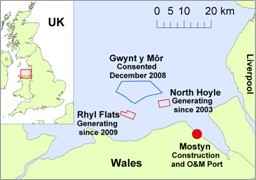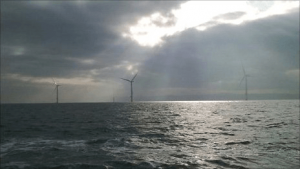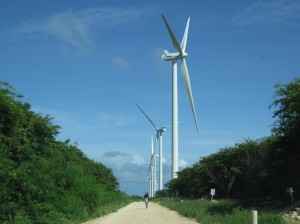On 13th October, British Energy Minister Charles Hendry announced Andrew Jamieson, chairman of green energy association Renewable U.K., will lead a panel of experts from the energy sector to find ways to cut the cost of offshore wind during the next decade.
“Offshore wind not only makes sense for our energy security and the environment but the economy too, bringing jobs and economic growth,” Hendry said in a statement. “I am pleased to be able to announce the members that will spearhead this vital work to drive down the costs of delivering our offshore wind ambitions.” Hendry’s new wind energy panel is to have its first meeting Tuesday.
His announcement follows plans by RWE Innogy to build a 576 megawatts wind farm in Liverpool Bay, off the Nort Wales/Liverpool coast. The facility, dubbed Gwynt y Mor, the Welsh phrase for “sea wind,” will go online by 2014.
The site is in a very favourable location: Liverpool Bay in North Wales is characterised by comparatively shallow water and very high wind speeds. There are existing wind farms in that area; North Hoyle, and Rhyl Flats (photo above).
RWE Innogy, Stadtwerke München (SWM – Munich Municipal Utility) and Siemens have entered into a joint venture to build Gwynt y Môr. RWE Innogy will hold a 60% stake in this joint venture, Stadtwerke München 30% and Siemens 10%. The total investment amounts to more than two billion Euros, including the grid connection to the coast. The investment will be divided between the partners accordingly. Siemens will also be responsible for connecting the wind turbines to the grid, which entails the delivery of two turnkey offshore transformer platforms. Using high-voltage sea cables, power will be transmitted to the Welsh town of St. Asaph, from where inland distribution will take place. Siemens will also be responsible for maintenance of the wind farm for five years, with the option of an extension for a further seven years.
Work will start in the next few weeks to erect the first foundations for a total of 160 wind turbines. All permits for the wind farm covering an area of 79 square kilometres have already been obtained. Siemens will supply, install and maintain the wind turbines, and provide the connection to the grid. At 576MW, Gwynt y Môr will be one of the largest offshore wind farms in construction in the world. RWE settled on the same type of turbine already standing on the Rhyl Flats and North Hoyle wind farms. Standing at 134m when the massive propellers reach the top of their arch, these windmills are the same height at Sydney Harbour Bridge. But while the existing turbines are just 7km off shore, the mid point of Gwynt Y Môr will be 18km from land.
In its first phase of expansion, the wind farm is planned to generate electricity as early as 2013. The project is expected to be completed in 2014. From then onwards it is forecast to generate around 1,950 gigawatt hours of electricity annually, enough to supply around 400,000 British households.
Predictably, not everyone is happy with the development. Mike Pritchard, of the pressure group Save Our Scenery, said: “If there is indeed a convincing argument for these wind farms, and we seriously doubt it, they should be much further away from the coast, especially in tourist areas like North Wales which depends so heavily on tourism.”
But that is a minority view: Secretary of State for Wales, Cheryl Gillan said the announcement was “excellent news.”
She said: “Gwynt y Môr will be one of the single biggest private investment projects ever seen in Wales, creating up to 1,000 quality jobs and contributing many millions of pounds to the regional economy of North Wales. It will also become one of the largest off-shore wind farm projects in Europe.”
Anne Meikle, head of World Wildlife Fund Cymru (Wales) said: “We have a real opportunity with Gwynt-y-Môr to use the powerful resource off the Conwy coast to help global efforts to fight climate change.”
Director of Friends of the Earth Cymru, Gordon James, said: “Gwynt y Môr provides an excellent opportunity to boost the green energy revolution that the Welsh Assembly Government is backing.”





